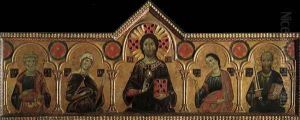Meliore Di Jacopo Paintings
Meliore di Jacopo, also known simply as Meliore, was an Italian painter whose life details are not well-documented, and whose birth year is unknown. He is primarily known for his work during the 13th century in Florence, Italy. His death is recorded to have occurred in 1276. Meliore's career unfolded during the Duecento, a period in Italian art history that predates the more famous Renaissance era. This was a time when Italian art was beginning to show more interest in naturalism and the representation of three-dimensional space on a two-dimensional surface.
Meliore is often associated with the Florentine painting school, which was beginning to break away from the Byzantine style that had dominated European art for centuries. His work includes a mix of the Byzantine influence as well as elements that point to the evolving Gothic style. Not much is known about his training or early career, but it is apparent from his existing work that he was proficient in the techniques and styles prevalent in Florence at the time.
Unfortunately, few works can be confidently attributed to Meliore. One of the challenges in studying artists like Meliore is the lack of signed or documented works, as the practice of signing art was not customary during this period. However, art historians have attributed certain pieces to Meliore based on stylistic analysis and historical records, such as payment records or mentions in contemporaneous documents.
One of the works attributed to Meliore is a fragment of a fresco from the church of San Pier Scheraggio in Florence, depicting the 'Madonna and Child'. This piece exhibits the transition from the Byzantine style to a more naturalistic approach. His figures begin to show more depth and volume, and there is a tender humanity in the depiction of the Madonna and Child that reflects the changing tastes of the period.
Meliore's contributions to the development of Florentine art are part of the larger narrative of the gradual shift towards the Renaissance. Although his individual influence may not be as prominent as that of later artists, his work provides valuable insight into the stylistic transformations that were taking place in Italian art during the 13th century. Meliore's death in 1276 marked the passing of an artist who was representative of the artistic currents of his time, and his works remain as vestiges of the nascent stages of the Italian Renaissance.
